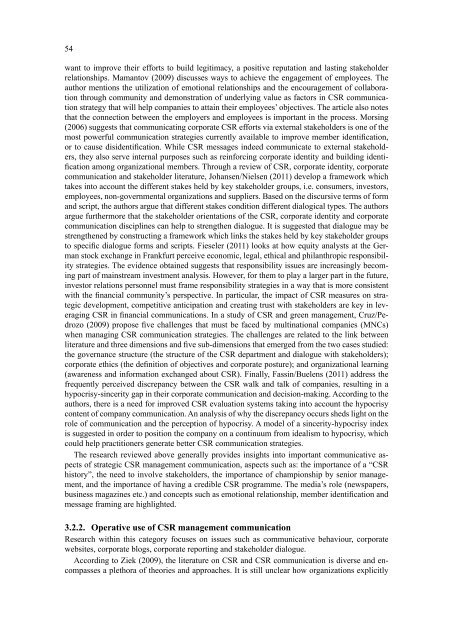Download - Hermes - Journal of Linguistics
Download - Hermes - Journal of Linguistics
Download - Hermes - Journal of Linguistics
Create successful ePaper yourself
Turn your PDF publications into a flip-book with our unique Google optimized e-Paper software.
54<br />
want to improve their efforts to build legitimacy, a positive reputation and lasting stakeholder<br />
relationships. Mamantov (2009) discusses ways to achieve the engagement <strong>of</strong> employees. The<br />
author mentions the utilization <strong>of</strong> emotional relationships and the encouragement <strong>of</strong> collaboration<br />
through community and demonstration <strong>of</strong> underlying value as factors in CSR communication<br />
strategy that will help companies to attain their employees’ objectives. The article also notes<br />
that the connection between the employers and employees is important in the process. Morsing<br />
(2006) suggests that communicating corporate CSR efforts via external stakeholders is one <strong>of</strong> the<br />
most powerful communication strategies currently available to improve member identification,<br />
or to cause disidentification. While CSR messages indeed communicate to external stakeholders,<br />
they also serve internal purposes such as reinforcing corporate identity and building identification<br />
among organizational members. Through a review <strong>of</strong> CSR, corporate identity, corporate<br />
communication and stakeholder literature, Johansen/Nielsen (2011) develop a framework which<br />
takes into account the different stakes held by key stakeholder groups, i.e. consumers, investors,<br />
employees, non-governmental organizations and suppliers. Based on the discursive terms <strong>of</strong> form<br />
and script, the authors argue that different stakes condition different dialogical types. The authors<br />
argue furthermore that the stakeholder orientations <strong>of</strong> the CSR, corporate identity and corporate<br />
communication disciplines can help to strengthen dialogue. It is suggested that dialogue may be<br />
strengthened by constructing a framework which links the stakes held by key stakeholder groups<br />
to specific dialogue forms and scripts. Fieseler (2011) looks at how equity analysts at the German<br />
stock exchange in Frankfurt perceive economic, legal, ethical and philanthropic responsibility<br />
strategies. The evidence obtained suggests that responsibility issues are increasingly becoming<br />
part <strong>of</strong> mainstream investment analysis. However, for them to play a larger part in the future,<br />
investor relations personnel must frame responsibility strategies in a way that is more consistent<br />
with the financial community’s perspective. In particular, the impact <strong>of</strong> CSR measures on strategic<br />
development, competitive anticipation and creating trust with stakeholders are key in leveraging<br />
CSR in financial communications. In a study <strong>of</strong> CSR and green management, Cruz/Pedrozo<br />
(2009) propose five challenges that must be faced by multinational companies (MNCs)<br />
when managing CSR communication strategies. The challenges are related to the link between<br />
literature and three dimensions and five sub-dimensions that emerged from the two cases studied:<br />
the governance structure (the structure <strong>of</strong> the CSR department and dialogue with stakeholders);<br />
corporate ethics (the definition <strong>of</strong> objectives and corporate posture); and organizational learning<br />
(awareness and information exchanged about CSR). Finally, Fassin/Buelens (2011) address the<br />
frequently perceived discrepancy between the CSR walk and talk <strong>of</strong> companies, resulting in a<br />
hypocrisy-sincerity gap in their corporate communication and decision-making. According to the<br />
authors, there is a need for improved CSR evaluation systems taking into account the hypocrisy<br />
content <strong>of</strong> company communication. An analysis <strong>of</strong> why the discrepancy occurs sheds light on the<br />
role <strong>of</strong> communication and the perception <strong>of</strong> hypocrisy. A model <strong>of</strong> a sincerity-hypocrisy index<br />
is suggested in order to position the company on a continuum from idealism to hypocrisy, which<br />
could help practitioners generate better CSR communication strategies.<br />
The research reviewed above generally provides insights into important communicative aspects<br />
<strong>of</strong> strategic CSR management communication, aspects such as: the importance <strong>of</strong> a “CSR<br />
history”, the need to involve stakeholders, the importance <strong>of</strong> championship by senior management,<br />
and the importance <strong>of</strong> having a credible CSR programme. The media’s role (newspapers,<br />
business magazines etc.) and concepts such as emotional relationship, member identification and<br />
message framing are highlighted.<br />
3.2.2. Operative use <strong>of</strong> CSR management communication<br />
Research within this category focuses on issues such as communicative behaviour, corporate<br />
websites, corporate blogs, corporate reporting and stakeholder dialogue.<br />
According to Ziek (2009), the literature on CSR and CSR communication is diverse and encompasses<br />
a plethora <strong>of</strong> theories and approaches. It is still unclear how organizations explicitly
















